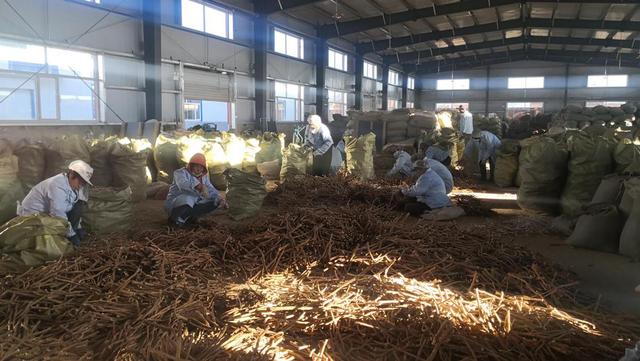TCM herb growth cures farmers' poverty woes


Zhang Youwen, a 60-year-old farmer in Wuzhai county, Shanxi province, used to grow potatoes and corn on his small patch of land, just as his parents and grandparents had done. Although farmwork kept him busy for most of the year, he only earned a meager income that was barely enough to take care of his family.
However, Zhang's life changed in 2017 when he decided to grow huangqi, or astragalus root, a herb used in traditional Chinese medicine, which helped increase his income to more than 10,000 yuan ($1,520), over triple what he earned before. Other farmers in the county have also turned to growing traditional Chinese herbs in recent years to lift themselves out of poverty.
Wuzhai, at an altitude of over 1,200 meters, has a cold climate, contributing to smaller crop yields than lower areas. In 2014, it was one of the poorest counties in Shanxi, with more than a third of farmers in the county living below the poverty line, according to local government statistics. Ironically, the county has highly-valued wild herbs in abundance, which have not been properly utilized.
In recent years the cultivation of herbs for medicinal purposes has been developed into a major business with the support of the National Administration of Traditional Chinese Medicine.
"Through site inspections we found many obstacles in the way of herb farming in Wuzhai, including a lack of knowledge and skills among farmers on how to grow herbs, as well as a shortage of infrastructure," said Dong Yunlong from the national administration, who is also deputy head of Wuzhai.
Since May 2018, with the support of local authorities, Dong has focused on developing the TCM industry in the county, including standardizing farming methods.
Bases have been established to reproduce the seeds of herbs used in TCM, nurture shoots and commercialize wild local herbs. An area to demonstrate the standardized growing procedure for huangqi has also been established.
By the end of last year, the planted area of TCM herbs in the county increased to 3,300 hectares, almost three times the area used in 2016. More than 6,000 villagers, including 2,200 impoverished people, have benefited from the changes, according to the county government.
TCM-related industries have also been developed in the county. With the support of the national administration, a TCM industrial park has been set up to provide a range of services, including technical guidance on the planting, processing, storage and sale of herbs.
With the help of the TCM industry, Wuzhai was lifted out of poverty in April last year, and more efforts are being made to develop it further.
Shanxi Huamiao Pharmaceutical is building a TCM workshop that is expected to produce 1,000 metric tons of drugs annually after it begins production late next year, said Ma Mingli, general manager of the company. "More job opportunities will be created for local farmers after the workshop begins production, which will also contribute to increased government revenue," Ma said.
Zhang Yuguang, Party chief of Wuzhai, said, "TCM has great potential, and further development of the industry, including TCM-derived beverages and food and tourism, will continue in Wuzhai to bring more benefits to the people."
- Most parts of country were warmer than usual in 2025
- Poverty relief transitions to governance
- 'Micro sports areas' boost students' fitness, fun
- China tips scales toward healthier living trends
- Anti-corruption efforts focus more on work conduct issues
- Deeper reflections on 'cave-dwelling conversation'




































